Cranking Conditions on Modular ECUs

Cranking conditions are different
from when the engine is actually running for several reasons:
The ECU determines whether the engine is cranking or in its running state by comparing the current engine speed to the cranking RPM threshold. If the engine speed is less than this RPM threshold then the ECU enters cranking mode which has different behaviour from when the engine is running, which is what I will describe in this article.
To get an engine to start nicely and reliably, there are a few considerations.
The first, and this is often overlooked but it’s crucial, is to have a good trigger setup. The earlier the ECU knows where TDC is and which cylinder it’s up to, the sooner it can start generating engine synchronous pulses like ignition and injector events. With the Select ECUs people would often describe a problem with their setup being “hard to start” and asking what they should do with the cranking settings, while all along the problem was they didn’t have a good trigger setup.
If the ECU shows RPM=1 during cranking, this means that the ECU knows that the engine is turning, for example it has seen some activity on CAS1, but it doesn’t yet know where TDC is. As a result it can’t fire any outputs. But we display the RPM as 1 instead of 0 during this time to help with problem diagnosis.
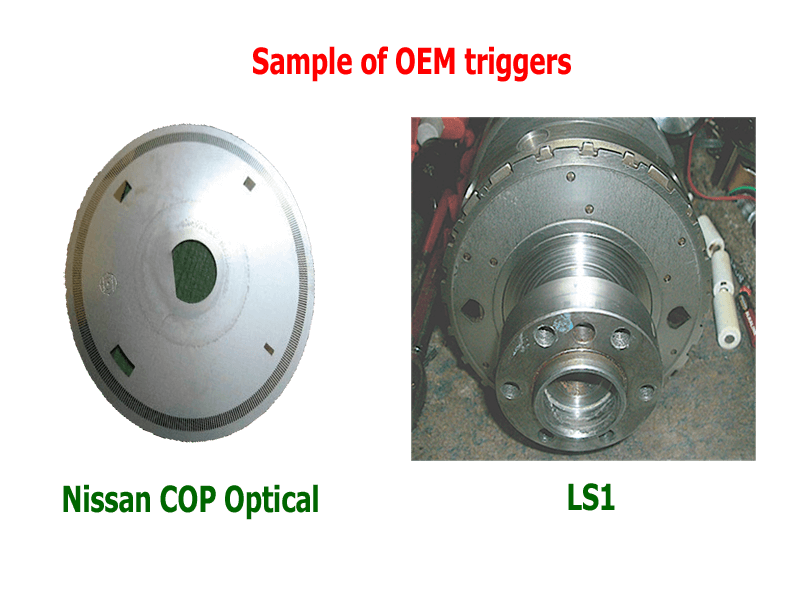
This means, apart from the fact that it actually has to work correctly (for example if you have a multitooth and a reset, then it won’t work if the reset is not working), that it’s a good idea to have a good trigger for your particular engine. OEMs generally know what they’re doing, and many OEM triggers for example the Nissan COP optical and LS1 have excellent trigger patterns which can tell the ECU where it is within the 720 degree cycle with 180 degrees of crank rotation or less. If you’re going to make changes to the OEM system then you need to understand the consequences of those changes – for example if you wire up a non-VVT 2JZ engine and only connect one of the cam triggers then it could take up to 6 nyehs before the ECU even knows where TDC is. Or if you convert a distributor type Nissan optical system to coil on plug, the engine may need to crank for up to a full cam revolution for the ECU to know which cylinder to fire (which is not an issue on the distributor system because the distributor handles that).
Next, we will consider battery voltage. The main effect of this is that there’s less voltage available to make the injector open. The injector needs a certain amount of force to open against the fuel pressure, and that force comes from the injector current. The current comes from the voltage, so at a lower battery voltage there’s less force available. This means that the injector dead time has to be set correctly against different voltages, which is why we recommend using injectors which we have characterised. One trap I’ve seen some young (and sometimes not so young) players fall into is to take a car which had low impedance injectors from the factory, with a series resistor pack in the original wiring – and change the injectors to high impedance type but leave the resistor pack in. If you remember Ohm’s law it will be obvious why this will cause problems, but the problem is that sometimes there’s still enough current with the resistor pack installed for the injector to open at 14V, but not at 10V or less when the engine is cranking. This can lead the inexperienced tuner to believe that there’s a cranking fuel problem.
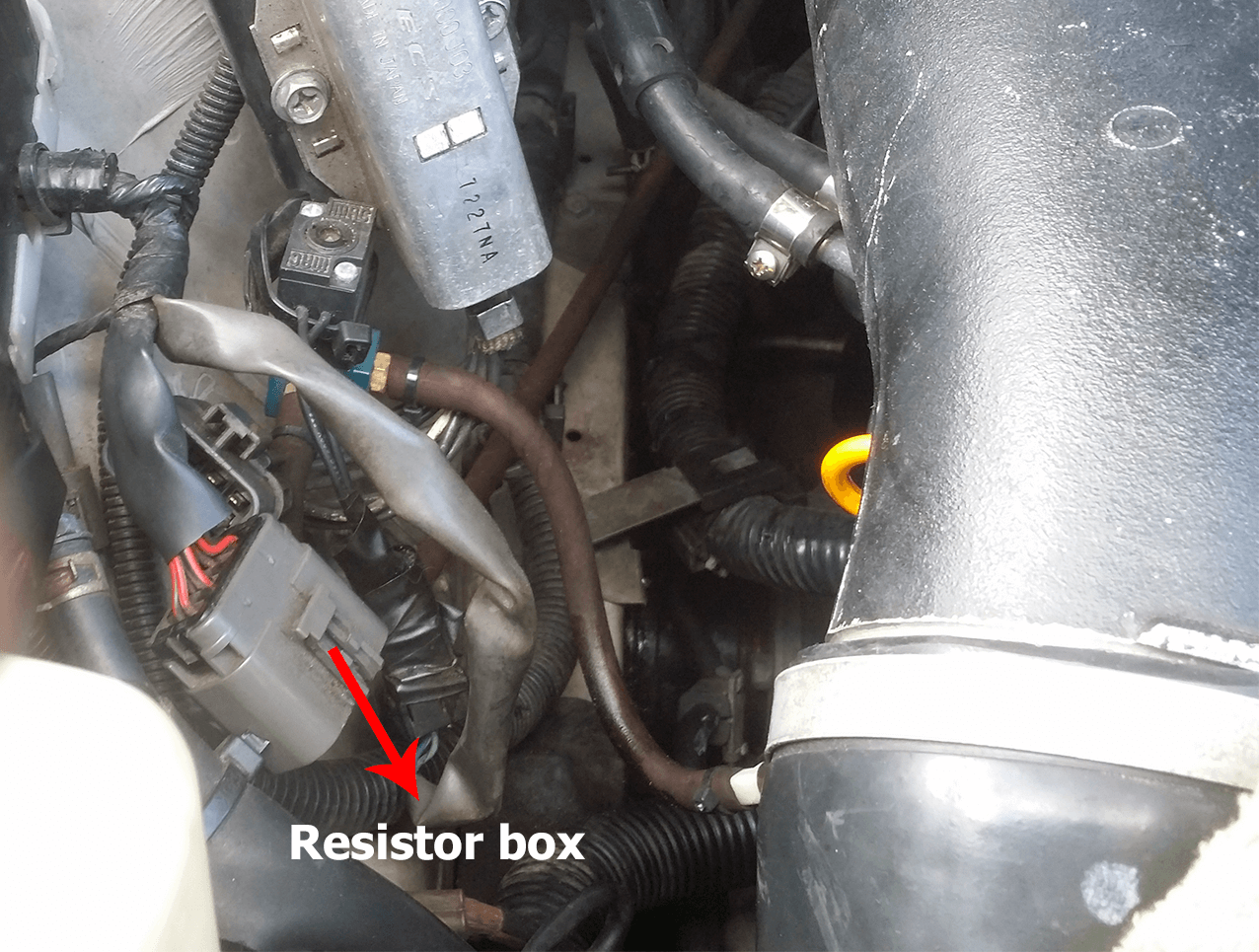
When the engine is stopped, and during cranking, the ECU will hold the idle valve open at 100%, to make the engine easier to start. This means that on a PWM idle control valve, it will be fully open. On a stepper motor idle controller, it means the ECU will fully retract the plunger which also has the benefit of homing the stepper motor. On an electronic throttle car, it means that the target throttle position will be the idle authority plus whatever the pedal is commanding – eg if the idle authority is 20% and the pedal is at 0%, then the target throttle position will be 20%.
Finally, we will discuss ignition and fuel delivery during cranking.
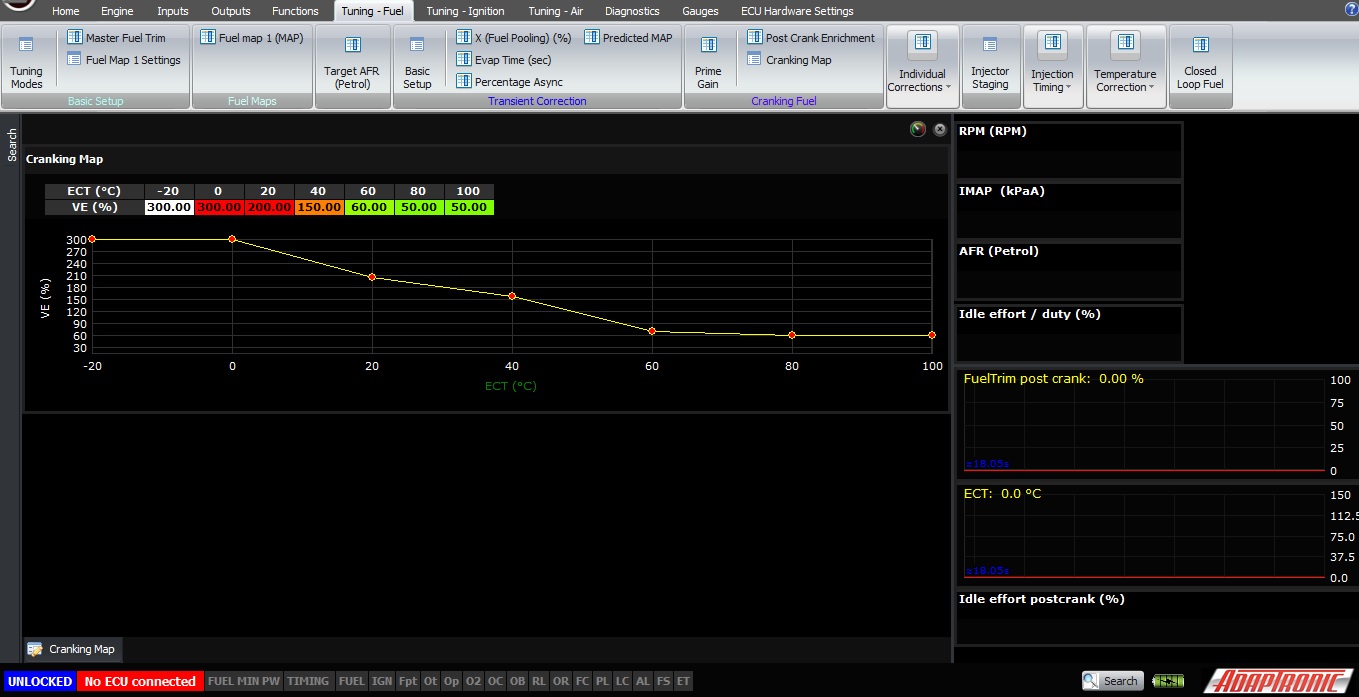
Ignition timing is controlled by a map of target ignition timing vs coolant temperature. The ECU may not have a good indication of the engine angle as the engine rotates, because as I mentioned before the engine speed changes a lot throughout the cycle. So the ECU will try to time the pulse based on that angle, but if it gets to a tooth past that angle and hasn’t fired yet, it will generate a pulse. So this means that pulses can be generated based on the availability of a trigger event close to TDC.
Most engines are happy to fire at about TDC during cranking – sometimes earlier, on some engines up to 10°BTDC. Some engines really don’t like this though, especially high compression ones, and sometimes firing too early can “stall” the starter motor. On some engines I’ve even heard of starter motors breaking and being flung off engines when this has happened. So before firing up an engine it’s usually a good idea to disable the fuel to the engine and crank just with the ignition, and check the timing with a light.
Lastly, we’ve come to the fuel delivery during cranking. This comes in two stages; the first is a prime pulse that fires on all the injectors at once to get an initial amount of fuel into the engine and wet the runner walls, and after that the injection pulses are delivered synchronously just as when the engine is running.
The first table we will look at is the Cranking Map, which you can find under fuel tuning -> cranking. This is a simple VE table (or you can override it to b e in milliseconds if you wish) against coolant temperature. If you are running flex fuel, then you will have one of these for E0 and one for E85. This is the VE of the engine at cranking, to get the right amount of fuel into the engine tog et it to fire. Normally we see values of about 80% when the engine is warmed up, and higher when the engine is cold, for example 150 – 200% on petrol / gasoline. On ethanol the cranking fuel needs to be even higher, for example 300%.
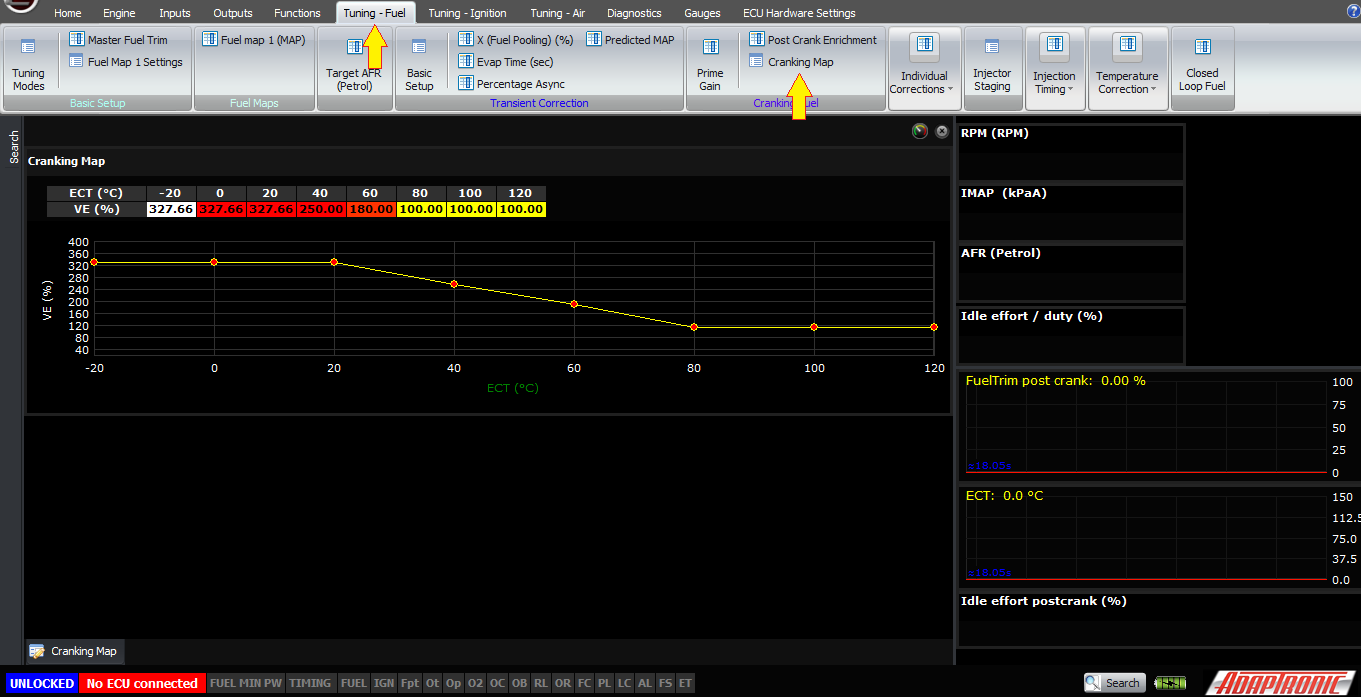

If you need to adjust the number and you’re not sure which way to go, here’s the technique I use. If the engine has too little fuel, then putting a bigger number in there will make it fire up more quickly. If it’s either very rich on immediate post-start, or it fails to start until you open the throttle and then it fires up, then that means you have too much fuel.
The next table we’ll talk about is the prime gain. This is a 3D table against coolant temperature and ethanol percentage. This is an asynchronous pulses on all the primary injectors at once, when the ECU first detects RPM. Note that it doesn’t need to know where TDC is, it just needs to see some activity on the CAS1 input. This prime gain is a percentage of the cranking pulse. So for example if your normal cranking pulse width is 10ms, and you put 50% in the prime gain table, then the ECU will do an asynchronous pulse of 5ms (assuming dead time = 0) when it detects the engine has started to rotate, on all the primary injectors.
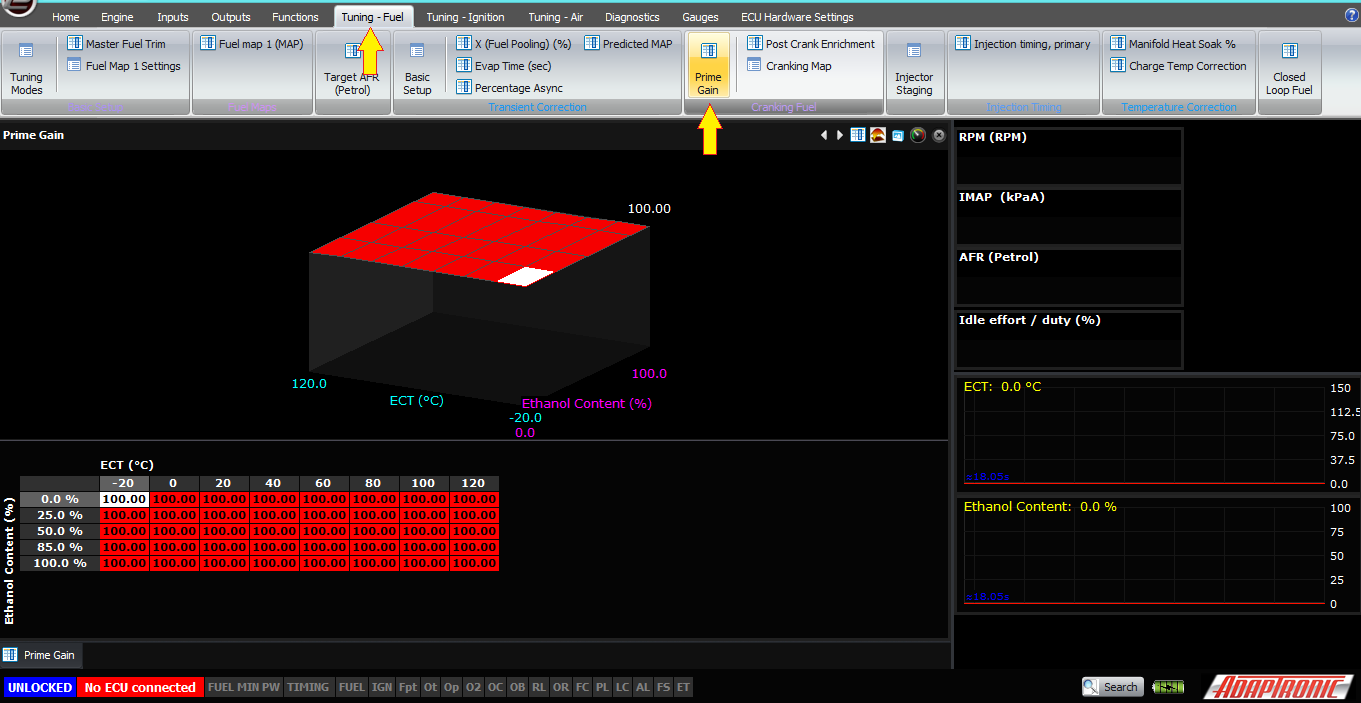
The final tables we’ll discuss are what happens after the engine fires up. The variable called “Time since starting engine” will start to count up from zero (in seconds), and this is used to reference two tables. One of them is the post crank enrichment – whose two axes are time (since starting the engine) and coolant temperature. The values in the table are then the percentage enrichment required.

The other table has the same axes and that’s the post-crank idle-up function. This additional idle effort gets added to the other idle calculations. While the ECU is in post-crank idle-up, which means that the interpolated value from the 3D map is greater than 1%, the ECU will not go into closed loop idle or overrun fuel cut.
- The engine speed is much lower, eg 180 – 240 RPM
- The engine speed changes throughout the cycle as each cylinder or rotor does its compression stroke (that’s the characteristic nyeh sound)
- The battery voltage is much lower than when the engine is running
The ECU determines whether the engine is cranking or in its running state by comparing the current engine speed to the cranking RPM threshold. If the engine speed is less than this RPM threshold then the ECU enters cranking mode which has different behaviour from when the engine is running, which is what I will describe in this article.
To get an engine to start nicely and reliably, there are a few considerations.
The first, and this is often overlooked but it’s crucial, is to have a good trigger setup. The earlier the ECU knows where TDC is and which cylinder it’s up to, the sooner it can start generating engine synchronous pulses like ignition and injector events. With the Select ECUs people would often describe a problem with their setup being “hard to start” and asking what they should do with the cranking settings, while all along the problem was they didn’t have a good trigger setup.
If the ECU shows RPM=1 during cranking, this means that the ECU knows that the engine is turning, for example it has seen some activity on CAS1, but it doesn’t yet know where TDC is. As a result it can’t fire any outputs. But we display the RPM as 1 instead of 0 during this time to help with problem diagnosis.

This means, apart from the fact that it actually has to work correctly (for example if you have a multitooth and a reset, then it won’t work if the reset is not working), that it’s a good idea to have a good trigger for your particular engine. OEMs generally know what they’re doing, and many OEM triggers for example the Nissan COP optical and LS1 have excellent trigger patterns which can tell the ECU where it is within the 720 degree cycle with 180 degrees of crank rotation or less. If you’re going to make changes to the OEM system then you need to understand the consequences of those changes – for example if you wire up a non-VVT 2JZ engine and only connect one of the cam triggers then it could take up to 6 nyehs before the ECU even knows where TDC is. Or if you convert a distributor type Nissan optical system to coil on plug, the engine may need to crank for up to a full cam revolution for the ECU to know which cylinder to fire (which is not an issue on the distributor system because the distributor handles that).
Next, we will consider battery voltage. The main effect of this is that there’s less voltage available to make the injector open. The injector needs a certain amount of force to open against the fuel pressure, and that force comes from the injector current. The current comes from the voltage, so at a lower battery voltage there’s less force available. This means that the injector dead time has to be set correctly against different voltages, which is why we recommend using injectors which we have characterised. One trap I’ve seen some young (and sometimes not so young) players fall into is to take a car which had low impedance injectors from the factory, with a series resistor pack in the original wiring – and change the injectors to high impedance type but leave the resistor pack in. If you remember Ohm’s law it will be obvious why this will cause problems, but the problem is that sometimes there’s still enough current with the resistor pack installed for the injector to open at 14V, but not at 10V or less when the engine is cranking. This can lead the inexperienced tuner to believe that there’s a cranking fuel problem.
When the engine is stopped, and during cranking, the ECU will hold the idle valve open at 100%, to make the engine easier to start. This means that on a PWM idle control valve, it will be fully open. On a stepper motor idle controller, it means the ECU will fully retract the plunger which also has the benefit of homing the stepper motor. On an electronic throttle car, it means that the target throttle position will be the idle authority plus whatever the pedal is commanding – eg if the idle authority is 20% and the pedal is at 0%, then the target throttle position will be 20%.
Finally, we will discuss ignition and fuel delivery during cranking.
Ignition timing is controlled by a map of target ignition timing vs coolant temperature. The ECU may not have a good indication of the engine angle as the engine rotates, because as I mentioned before the engine speed changes a lot throughout the cycle. So the ECU will try to time the pulse based on that angle, but if it gets to a tooth past that angle and hasn’t fired yet, it will generate a pulse. So this means that pulses can be generated based on the availability of a trigger event close to TDC.
Most engines are happy to fire at about TDC during cranking – sometimes earlier, on some engines up to 10°BTDC. Some engines really don’t like this though, especially high compression ones, and sometimes firing too early can “stall” the starter motor. On some engines I’ve even heard of starter motors breaking and being flung off engines when this has happened. So before firing up an engine it’s usually a good idea to disable the fuel to the engine and crank just with the ignition, and check the timing with a light.
Lastly, we’ve come to the fuel delivery during cranking. This comes in two stages; the first is a prime pulse that fires on all the injectors at once to get an initial amount of fuel into the engine and wet the runner walls, and after that the injection pulses are delivered synchronously just as when the engine is running.
The first table we will look at is the Cranking Map, which you can find under fuel tuning -> cranking. This is a simple VE table (or you can override it to b e in milliseconds if you wish) against coolant temperature. If you are running flex fuel, then you will have one of these for E0 and one for E85. This is the VE of the engine at cranking, to get the right amount of fuel into the engine tog et it to fire. Normally we see values of about 80% when the engine is warmed up, and higher when the engine is cold, for example 150 – 200% on petrol / gasoline. On ethanol the cranking fuel needs to be even higher, for example 300%.


If you need to adjust the number and you’re not sure which way to go, here’s the technique I use. If the engine has too little fuel, then putting a bigger number in there will make it fire up more quickly. If it’s either very rich on immediate post-start, or it fails to start until you open the throttle and then it fires up, then that means you have too much fuel.
The next table we’ll talk about is the prime gain. This is a 3D table against coolant temperature and ethanol percentage. This is an asynchronous pulses on all the primary injectors at once, when the ECU first detects RPM. Note that it doesn’t need to know where TDC is, it just needs to see some activity on the CAS1 input. This prime gain is a percentage of the cranking pulse. So for example if your normal cranking pulse width is 10ms, and you put 50% in the prime gain table, then the ECU will do an asynchronous pulse of 5ms (assuming dead time = 0) when it detects the engine has started to rotate, on all the primary injectors.

The final tables we’ll discuss are what happens after the engine fires up. The variable called “Time since starting engine” will start to count up from zero (in seconds), and this is used to reference two tables. One of them is the post crank enrichment – whose two axes are time (since starting the engine) and coolant temperature. The values in the table are then the percentage enrichment required.

The other table has the same axes and that’s the post-crank idle-up function. This additional idle effort gets added to the other idle calculations. While the ECU is in post-crank idle-up, which means that the interpolated value from the 3D map is greater than 1%, the ECU will not go into closed loop idle or overrun fuel cut.
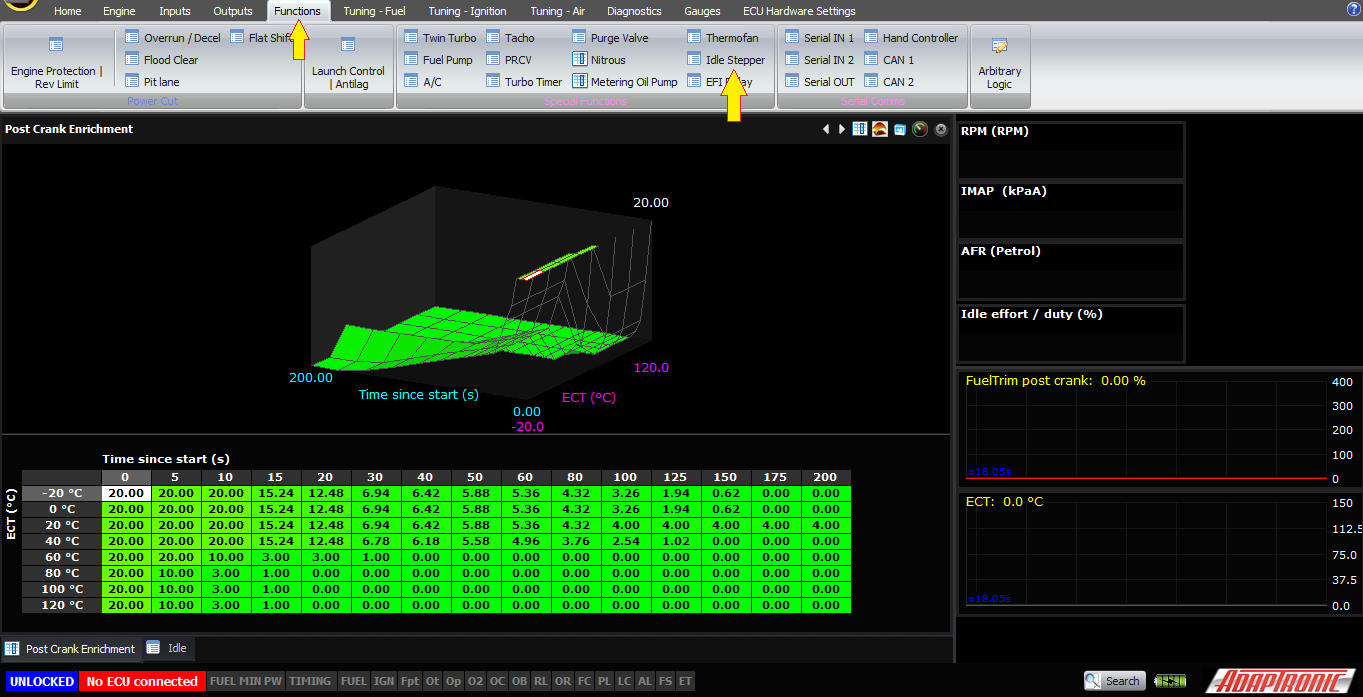
Functions>Idle Stepper>Base Idle>Post Crank Idle
There are a few variables to get right, but once you do it’s nice to have an engine that starts like an OEM engine.
Thank you.
©2018 Adaptronic